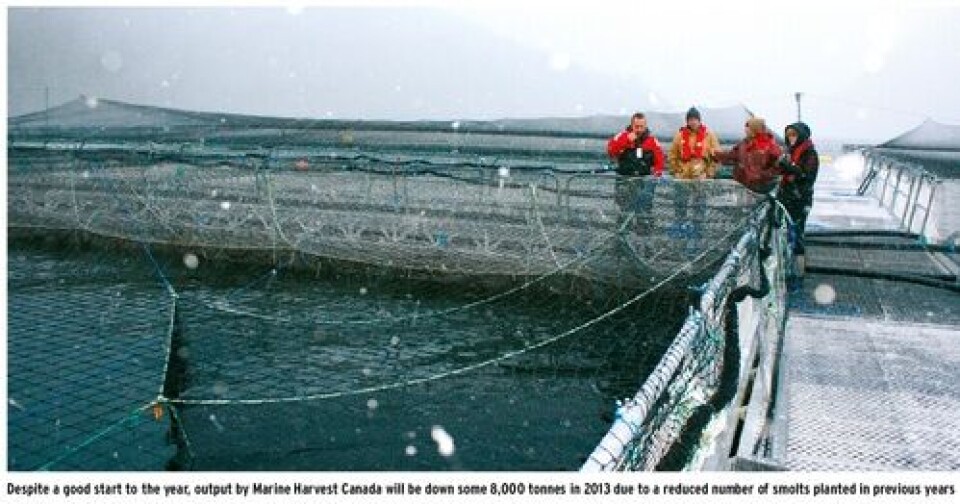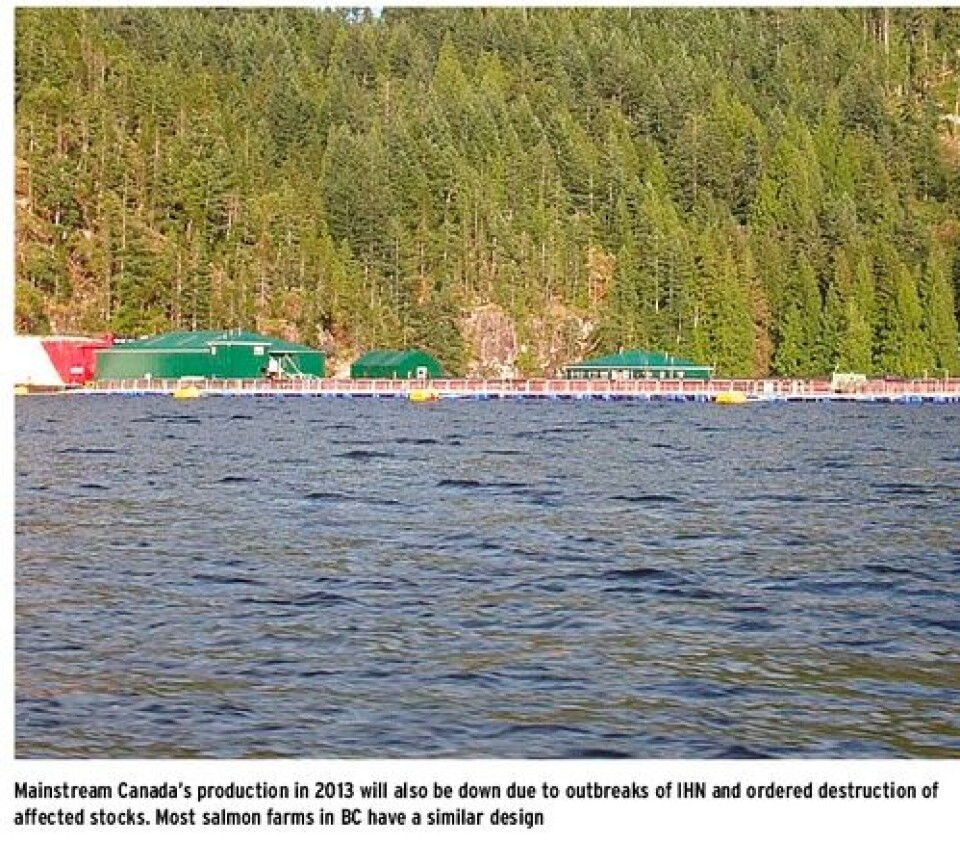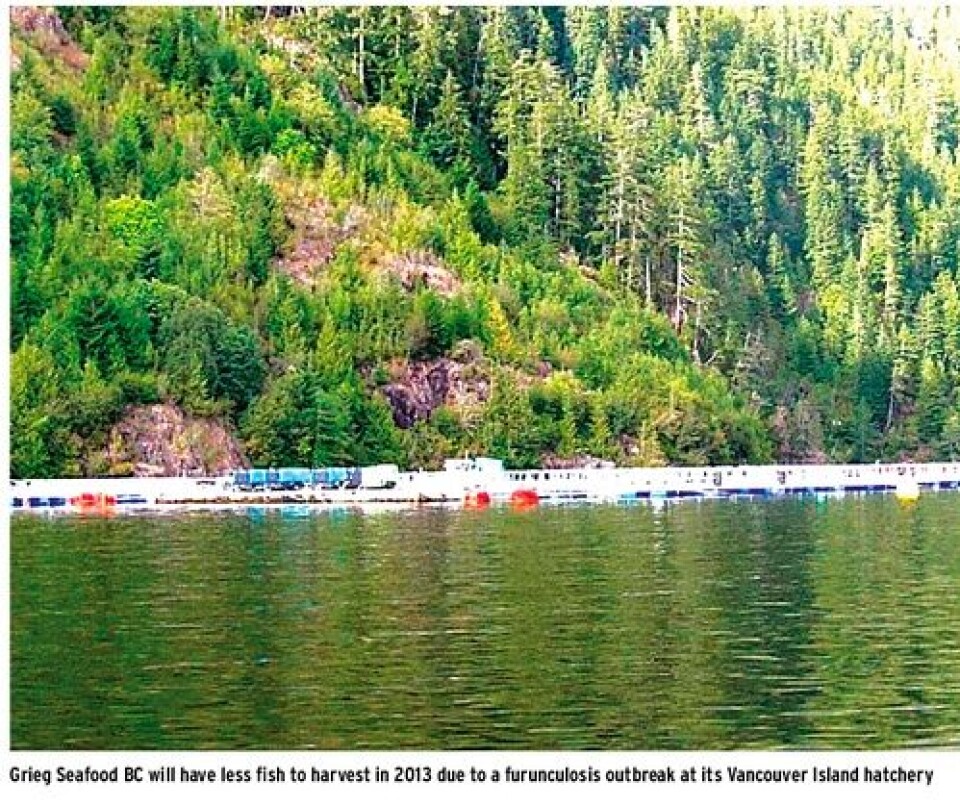Political Excitement and Profitability return for Salmon Farmers in British Columbia
Odd Grydeland odd@fishfarmingxpert.com

Most people familiar with the business of salmon farming in British Columbia will agree that there is seldom a “dull moment” in this industry. And so it was with the run-up to the May 14 Provincial election. Most public opinion polls suggested that a new government would be formed by the leader of the New Democratic Party (NDP), Mr. Adrian Dix. During the week leading up to the election, a group of environmental activists and others confronted Mr. Dix, demanding to hear his position on conventional salmon farming. The group allegedly handed over a stack of over 60,000 signatures calling for “the end to what they call the feedlot expansion of fish farming on the province’s coast”, according to an article in The Vancouver Sun. But while Mr. Dix didn’t state a particular position on the issue, he rather suggested that salmon farming was largely a federal issue following a 2009 court case that deemed ocean fish farming to be “a fishery”, which should be regulated by the Federal Department of Fisheries and Oceans (DFO).
The information closest to a positional statement by the NDP prior to the election was perhaps provided by the sitting member of the provincial government- Member of the Legislative Assembly (MLA) representing Northern Vancouver Island. In a statement to a local newspaper, NDP’s Claire Trevena also largely skirted the issue by referring to the federal jurisdiction, as well as to a few recommendations about salmon farming contained in a report by a Provincial judge (Justice Bruce Cohen) who was hired to look into an unusually poor return of sockeye salmon in 2009 to the Fraser River;
“The B.C. NDP has explicitly stated that it is strongly in favour of implementing the recommendations of the Cohen Commission Report and is committed to working to achieve their implementation. This report, exploring the decline of sockeye in the Fraser River, was wide-ranging and comprehensive in its recommendations. It must be remembered that, as a consequence of a legal challenge brought in 2009, the BC Supreme Court ruled that the federal government has exclusive jurisdiction for open-net aquaculture. This ruling severely limits the province’s ability to regulate in this area. We are disappointed the Department of Fisheries and Oceans has not moved promptly to implement Justice Cohen’s recommendations. Last May, my party stated that we are firmly committed to working with and, if necessary, pressuring DFO to act if we form government. The recommendations include: using the precautionary principle to re-evaluate risk and mitigation measures for salmon farms in the Discovery Islands including closing farms that pose a serious risk to migrating salmon, limiting salmon farm production and licenses, and maintaining the existing moratorium on new fish farm licenses on the North Coast. We are watching with interest the development of land-based, closed containment fish farm projects in the North Island, projects that I support. An area where the province does have jurisdiction is renewing leases for the siting of fish farms. Unfortunately, the BC Liberals have not developed neither the capacity nor clear policy directives to handle this responsibility. The BCNDP will develop them if we form government”.

Ironically, when the Cohen Commission was in the middle of its hearings, the biggest run of sockeye salmon in a hundred years swam up the same Fraser River. Another statement regarding salmon aquaculture provided by a NDP MLA came from Mr. John Horgan, a representative from the Victoria region on the southern end of Vancouver Island, where he was quoted by a journalist from BC Local News; “Horgan denied that he is advocating the shutdown of existing fish farms. He said closed-containment technology using bags suspended in the ocean is developing, and existing leases for net-pen salmon farms will eventually expire. “Closed containment is the only way I can see the aquaculture industry surviving in the long term,” he said. And in 2007, a NDP-dominated Special Committee on Sustainable Aquaculture came up with the following recommendations regarding finfish (salmon) farming; • A rapid, phased transition to ocean-based closed containment (should) begin immediately. Within three years ocean-based closed containment must be developed. Once developed, industry must transition to this technology within the subsequent two years. • To meet the initial three year deadline, the provincial government, in partnership with the federal government and the salmon aquaculture industry, must urgently finance and conduct a full commercial scale ocean-based closed containment project. • The provincial government should develop and provide incentives to the aquaculture industry to facilitate the transition to ocean-based closed containment technology.

Representing the other side of the B.C. Legislature floor, the new B.C. Liberal candidate for the riding of Vancouver Island North- 25 year old PhD-student Nick Facey- made the following statement to the same newspaper that interviewed the local NDP candidate;
Salmon aquaculture is a very important sector in British Columbia and particularly in the North Island area. It employs thousands of people, creates opportunities for First Nations communities, and creates an environment for a strong network of secondary supply businesses that keep our economy strong, growing and stable. That said, aquaculture can only be supported knowing that it is being done responsibly. I believe that the extensive work done by the industry and the stringent regulations developed by the federal and provincial governments meet that standard. The BC Liberal government has already voiced its support of the Cohen Commission recommendations that would see a review of siting regulations, additional research in the Discovery Islands and a moratorium on new sites in that area; and I stand by that commitment. With good management and strong oversight, I believe aquaculture will continue to be an important part of the North Island’s future. Last week I was able to visit the Marine Harvest Canada processing plant in Port Hardy and it is clear how important a facility of that size is for the community. I’ve also been able to tour salmon farms and hatcheries myself and meet the people who proudly take care of their fish. It represents many jobs – good jobs – so ensuring that this sector is sustainable is important to our riding. When all was said and done, the NDP- despite being ahead in most opinion polls by anywhere between ten and twenty percent- lost the election on May 14 to the B.C. Liberal Party, which elected 50 members compared with 33 for the NDP. In the riding of Vancouver Island North, the NDP candidate won by garnering 50.5% of the votes cast.

A third political party headed by former fisherman John Cummins failed to elect a single member to the B.C. government, but the BC Green Party succeeded in electing one of its candidates.
No doubt happy with the BC Liberal’s election victory, the salmon farmers in British Columbia will likely be hoping for an opportunity to expand their businesses in the Province. While the regulatory regime for aquaculture largely rests with the federal government, the Province still maintains control of the issuing of tenures for Crown Land- a document that all ocean farms require. These tenures can be a License of Occupation or a Foreshore Lease, and they can be issued for a period of up to 20 years.

The financial numbers for the three main salmon farming companies with farms in B.C. (Marine Harvest, Mainstream and Grieg Seafood) are now available, and their operational earnings in 2012 were as follows, with the numbers for the first quarter of 2013 included (all before adjustments for fair value): One NOK equals ~0.174 CAD$ and ~0.0.133 Euro (May 16, 2013) The main reason for the improvement in results for the first quarter of 2013 was an increase in the selling price for Atlantic salmon in the US market- this despite a double-digit increase in supply. For example, Mainstream Canada reports a 26% increase in the selling price during the first quarter of this year compared with that of Q4 2012- from US$ 2.10/lb (~€ 3.60/Kg) to US$ 2.70/lb (~€ 4.62/Kg). During the first quarter of 2013, a total of 80,300 tonnes of farmed salmon was consumed in the US, which is up by about 13.7% compared to the same period in 2012. For the full year (Q2 2012 to Q1 2013), the estimates show an increase from the previous 12 months of about 46,000 tonnes- a 16.8% increase (Kontali). Most of these additional tonnes came from Chile, while the imports of Atlantic salmon to the US from Europe fell by some 11,300 tonnes or 14.4% during the year.
Production in the Americas increased by 39% during this period, with Chilean production being responsible for most of this increase, having moved ahead by over 134,000 tonnes, which is up by 57.8% from the year before. A further increase in production from Chile of approximately 30% or about 98,000 tonnes is expected for the 2013 calendar year compared with 2012, while North American production is expected to take a drop of 10-15%.
The market distribution of Atlantic salmon saw the~14.7% increase in production during 2012 divided by countries/regions as follows;
Marine Harvest Canada The company harvested 12, 232 tonnes of farmed salmon during the first quarter of 2013, which was up by 1,600 tonnes compared with Q1 2012. Marine Harvest Canada produced just over 40,000 tonnes during 2012 (very close to the same amount produced by the company’s sister divisions in both Scotland and Chile), and expects to harvest about 32,000 tonnes this year due to a reduced output of smolts during the past two years. Besides the increases in selling prices to the US market, the positive development of the company’s bottom line this year is also attributed to the restructuring measures that were taken over the past two years. Besides, the first quarter is usually the seasonally best period to sell farmed salmon, says the company.
Some 83% of all salmon sold by Marine Harvest Canada during Q1 2013 were graded as Superior or Premium quality fish, compared with a Marine Harvest Group average of 85%. The company charged NOK 6 million to “exceptional items” during the first quarter of this year, and its Fair Value adjustments for the 2012 calendar year came to a negative NOK 23 million. Marine Harvest Canada owns about 55% of all the salmon farms in B.C., and if the contemplated purchase by Marine Harvest of Cermaq goes through, Marine Harvest Canada will own approximately 75% of the production capacity in the Province.
Mainstream Canada The company (MC) was the first salmon farming company to achieve a two-star Best Aquaculture Practises (BAP) certification for both farming and processing in B.C.- this happened in December last year. Mainstream Canada’s parent company Cermaq’s September, 2012 Sustainability Report was also rated to be the best by Seafood Intelligence. Harvesting during the first quarter of 2013 amounted to 3,800 tonnes compared with 2,800 tonnes during the comparable quarter in 2012. For the 2012 fiscal year, Mainstream Canada harvested 19,000 tonnes, and the company expects to produce some 16,000 tonnes this year. The drop in production is mainly contributed to the loss of fish from two of the company’s farms on the West Coast of Vancouver Island last year due to a viral infection of Infectious Hematopoietic Necrosis (IHN).
Mainstream Canada reported a reduction in production costs of 4% in Q1 2013 compared with Q1 2012, and a drop of 9% compared with the last quarter of 2012- this mainly due to the harvesting of fish from some of the best performing farm sites.

Grieg Seafood BC The company has been trying to source salmon smolts from other producers while it undergoes a thorough disinfection process at its hatchery in Gold River on Vancouver Island. An outbreak of furunculosis necessitated the destruction of a large part of the company’s smolt stocks last year, and a subsequent write-down of NOK 43 million was recorded in Grieg Seafood BC’s 2012 books. The first smolts from the renovated hatchery are expected to be delivered to company farms in August or September this year.
According to its Annual Report for 2012, Grieg Seafood said that “A number of improvements have been implemented at the smolt facility in BC in order to minimise the risk of outbreaks of disease of this kind in the future. The steps taken are expected to result in substantially improved biological production in the period ahead. The smolt facility has been disinfected and a number of technical and organisational initiatives have been implemented, or are in the process of implementation. Cost levels will be adapted to the reduction in production. On the positive side, the biological development of sea production in Canada has been stable and satisfactory over the last few years”.

Contrary to previous years, the sale by Grieg Seafood BC of Pacific salmon, including sales of roe for consumption, did also negatively affect the results for last year, “as reflected in both realized sale prices and cost levels”. The company harvested 13,576 tonnes of product in 2012, just slightly ahead of the previous year. A big drop to about 8,000 tonnes is expected this fiscal year. During the first quarter of 2013, a total of 1,939 tonnes was harvested compared with 3,893 tonnes during the first quarter of 2012.





















































